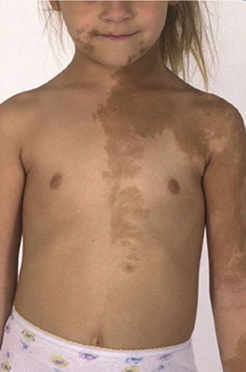WBR0166
Jump to navigation
Jump to search
| Author | [[PageAuthor::William J Gibson (Reviewed by Yazan Daaboul, M.D. and Alison Leibowitz [1])]] |
|---|---|
| Exam Type | ExamType::USMLE Step 1 |
| Main Category | MainCategory::Genetics |
| Sub Category | SubCategory::Endocrine |
| Prompt | [[Prompt::A 7-year-old girl is brought to the pediatrician's office for vaginal spotting. Upon further questioning, the mother reports that her daughter's history is significant for a "birthmark" that is pictured from a previous visit (shown below) and several bone fractures throughout childhood. Physical examination is remarkable for breast tissue development, presence of pubic hair, and a palpable lump of the craniofacial bone. Xrays of the patient's proximal femur and the skull base demonstrate expansile lesions with endosteal scalloping and a ground-glass appearance of the intramedullary tissue. Skeletal abnormalities associated with his patient's condition are caused by which of the following mechanism? |
| Answer A | AnswerA::Normal bone mineralization with loss of trabecular bone mass and interconnections |
| Answer A Explanation | [[AnswerAExp::Osteoporosis involves an imbalance between skeletal resorption and skeletal formation. Osteoporosis is associated with normal bone mineralization with loss of trabecular bone mass and interconnections. It is associated with poor mineralization and skeletal fragility. Increased osteoclastic activity causes osteoporosis.]] |
| Answer B | AnswerB::Decreased mineralization of osteoid |
| Answer B Explanation | [[AnswerBExp::Decreased mineralization of osteoid is often caused by vitamin D deficiency. It often results in rickets in children or osteomalacia in adults.]] |
| Answer C | AnswerC::Inappropriately increased PTH secretion |
| Answer C Explanation | [[AnswerCExp::In primary hyperparathryroidism, the excessive PTH production often results in osteitis fibrosa cystica.]] |
| Answer D | AnswerD::Increased osteoclastic activity followed by a compensatory increase in osteoblastic activity |
| Answer D Explanation | [[AnswerDExp::Paget's disease of bone is caused by increased bone turnover. Although both osteoclastic and osteoblastic activities are increased, Paget's disease of the bone is in fact characterized by the net increase in osteoclastic activity with a less significant compensatory increase in the osteoblastic activity.]] |
| Answer E | AnswerE::Replacement of bone with fibrous tissue |
| Answer E Explanation | [[AnswerEExp::Fibrous dysplasia is a feature of McCune-Albright syndrome.]] |
| Right Answer | RightAnswer::E |
| Explanation | [[Explanation::McCune-Albright syndrome (MAS) is a rare disease that involves the triad: fibrous dysplasia of bone, cutaneous cafe-au-lait spots, and precocious puberty. The disease is caused by mutations in GNAS gene that encodes the regulatory Gs-alpha protein. Fibrous dysplasia is almost always present in all cases of MAS and may be either monostotic (single skeletal site involvement) or polyostotic (multiple skeletal site involvement). Although cafe-au-lait spots are often the presenting feature of MAS (present since birth or shortly after), patients with MAS usually present with complaints of either fibrous dysplasia (bone pain, limp, painless lump, or pathological fracture) or precocious puberty (vaginal spotting or bleeding or early development of breast and/or pubic hair). The radiographic appearance of bone lesions in fibrous dysplasia are characteristic. Similar to the presentation in the vignette, radiographs may reveal expansile, lytic lesions with endosteal scalloping, cortical thinning, shepherd's crook deformity (coxa vara of the femur), and ground-glass appearance of the intramedullary tissue. Bone lesions usually involve the metaphysis and the diaphysis but spare the epiphysis. They typically arise in the medullary cavity and replace the normal bone by outward expansion. Educational Objective: McCune-Albright syndrome (MAS) is a rare disease that involves the triad: fibrous dysplasia of bone, cutaneous cafe-au-lait spots, and precocious puberty. The disease is caused by mutations in GNAS gene that encodes the regulatory Gs-alpha protein. |
| Approved | Approved::Yes |
| Keyword | WBRKeyword::McCune-Albright syndrome, WBRKeyword::Endocrine, WBRKeyword::Endocrinology, WBRKeyword::Genetics, WBRKeyword::Mosaicism, WBRKeyword::Somatic, WBRKeyword::McCune, WBRKeyword::Albright, WBRKeyword::McCune Albright syndrome, WBRKeyword::Fibrous dysplasia |
| Linked Question | Linked:: |
| Order in Linked Questions | LinkedOrder:: |
